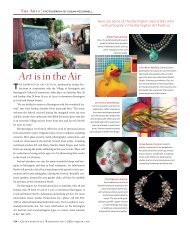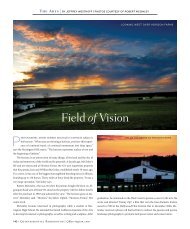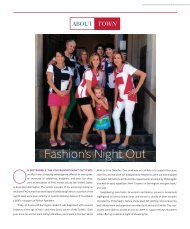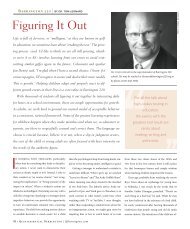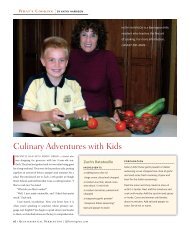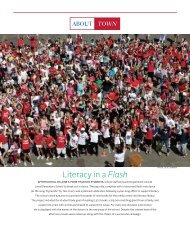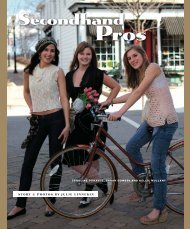The Wine of Kings, and the King of Wines - Quintessential ...
The Wine of Kings, and the King of Wines - Quintessential ...
The Wine of Kings, and the King of Wines - Quintessential ...
You also want an ePaper? Increase the reach of your titles
YUMPU automatically turns print PDFs into web optimized ePapers that Google loves.
Reprinted with Permission – Quintesstential Barrington ® Magazine –Copyright ©2007<br />
Italy’s Barolo:<br />
<strong>The</strong> <strong>Wine</strong> <strong>of</strong> <strong><strong>King</strong>s</strong>, <strong>and</strong> <strong>the</strong><br />
<strong>King</strong> <strong>of</strong> <strong>Wine</strong>s<br />
<strong>The</strong> cooler temperatures <strong>of</strong> late winter<br />
<strong>and</strong> early spring beg for a hearty red<br />
wine, so let’s take a trip to my favorite wine<br />
region, Piemonte. It’s an Italian region that<br />
includes Torino (<strong>the</strong> site <strong>of</strong> <strong>the</strong> February<br />
2006 Olympic games) <strong>and</strong> is <strong>the</strong> home <strong>of</strong><br />
Barolo, a robust red <strong>of</strong>ten described as <strong>the</strong><br />
“wine <strong>of</strong> kings <strong>and</strong> <strong>the</strong> king <strong>of</strong> wines.”<br />
Having spent more than a year over<br />
<strong>the</strong> past decade in Piemonte, I developed<br />
a passion for this region’s food, wine, <strong>and</strong><br />
people. Through close friendships with<br />
some <strong>of</strong> Italy’s most famous winery owners,<br />
including Altare, Conterno, Vietti, Marcarini,<br />
Marchesi di Barolo, <strong>and</strong> Gaja, I feel<br />
fortunate to have had my greatest wine experiences<br />
in Piemonte.<br />
Barolo is generally considered Italy’s<br />
highest quality wine, according to local<br />
growers. It is also heralded as <strong>the</strong> world’s<br />
second most robust wine. Barolo wine is<br />
named from <strong>the</strong> Italian word “nebbia,”<br />
which means fog. <strong>The</strong> Nebbia grape bears a<br />
unique gray hue resembling a fog that blankets<br />
its red skin.<br />
This wine dem<strong>and</strong>s food. At minimum,<br />
an aged Parmigiana is required to counter<br />
<strong>the</strong> wine’s high acidity. Alternatively, my favorite<br />
meal is aged Barolo with risotto or<br />
pasta with shaved white truffles. <strong>The</strong>se combinations<br />
can be found in Piemonte from<br />
September to December, accompanied by a<br />
fat wallet. Unfortunately, such experiences<br />
can rarely be found in <strong>the</strong> best U.S. Italian<br />
restaurants.<br />
If you’re unable to make it to Italy, my favorite<br />
meal with a great Barolo is fettuccini<br />
Alfredo <strong>and</strong> veal scaloppini Marsala. O<strong>the</strong>r<br />
great combinations with Barolo range<br />
from grilled steak or rack <strong>of</strong> lamb to beef<br />
braised in Barolo. My sole contribution<br />
to great cuisine involves <strong>the</strong> substitution<br />
<strong>of</strong> Barolo (or Spanna, Gattinara, Ghemme<br />
— all made from <strong>the</strong> Nebbia grape) in <strong>the</strong><br />
recipe for Beef Bourguignon, accompanied<br />
by a great Barolo with <strong>the</strong> meal. This idea<br />
stemmed from <strong>the</strong> fact that <strong>the</strong> Nebbiolo<br />
grape is genetically linked to Pinot Noir,<br />
which I believe lacks <strong>the</strong> body to best complement<br />
such a robust meal, even though<br />
it’s generally used in <strong>the</strong> recipe <strong>and</strong> served<br />
as <strong>the</strong> wine <strong>of</strong> choice.<br />
<strong>The</strong> great controversy over <strong>the</strong> past two<br />
decades involves whe<strong>the</strong>r Barolo made in<br />
<strong>the</strong> traditional style (e.g., Giacomo Conterno<br />
or Bartolo Mascarello) or in <strong>the</strong> modern<br />
style (e.g., Elio Altare or Angelo Gaja)<br />
is <strong>the</strong> better wine. <strong>The</strong> modern school<br />
produces riper <strong>and</strong> fruitier wines due to<br />
shorter masceration <strong>and</strong> <strong>the</strong> vanilla flavors<br />
imparted by <strong>the</strong> French barrels used for<br />
aging <strong>the</strong> wine. <strong>The</strong> traditionalist school<br />
uses longer masceration times with aging in<br />
large older oak casks (typically Slovenian),<br />
Down Cellar<br />
Photo: Thomas Balsamo<br />
which do not impart <strong>the</strong> vanilla flavors <strong>of</strong><br />
new French oak. In general, most <strong>of</strong> <strong>the</strong><br />
modern style wines also come from <strong>the</strong><br />
northwestern part <strong>of</strong> <strong>the</strong> Barolo zone—an<br />
area <strong>of</strong> gentle to steep hills with soils rich in<br />
magnesium <strong>and</strong> manganese. <strong>The</strong> traditionalist<br />
wines more <strong>of</strong>ten come from <strong>the</strong> sou<strong>the</strong>astern<br />
portion <strong>of</strong> <strong>the</strong> zone, with soils rich in<br />
iron. Modern-style Barolos <strong>of</strong>ten have aromas<br />
<strong>of</strong> soil, truffles, mint, <strong>and</strong> rose petals,<br />
along with vanilla. <strong>The</strong> traditionalist school<br />
involves more tones <strong>of</strong> tobacco, tar, smoke,<br />
<strong>and</strong> minerals. Certainly, if <strong>the</strong> wine is to be<br />
consumed early, <strong>the</strong> modern style is easier<br />
to enjoy. This debate has subsided recently,<br />
in part because <strong>the</strong> two schools, led by Mascarello<br />
<strong>and</strong> Altare, essentially declared that<br />
while differences abound when <strong>the</strong>se wines<br />
are young, once <strong>the</strong>y have aged about 10 to<br />
15 years, <strong>the</strong>re are more similarities than<br />
(continued next page)<br />
March/April 06–Down Cellar
Reprinted with Permission – Quintesstential Barrington ® Magazine –Copyright ©2007<br />
March/April 06–Down Cellar | Jim Bryant–<strong>The</strong> <strong>King</strong> <strong>of</strong> kings, <strong>and</strong> <strong>the</strong> <strong>King</strong> <strong>of</strong> <strong>Wine</strong>s<br />
differences. Both went on record to express <strong>the</strong>ir fondness for<br />
well-made wines <strong>of</strong> each style.<br />
As is <strong>the</strong> case for all great wines, Barolo is much enhanced if it is<br />
stored well <strong>and</strong> drunk from proper stemware. <strong>The</strong> glass should be<br />
thin with large bowls to invite <strong>the</strong> wine’s aroma. Large bowls also<br />
allow <strong>the</strong> wine to aerate; one hour poured in a decanter or wine<br />
glass equals one year in <strong>the</strong> bottle. This way you can buy time; this<br />
is true whe<strong>the</strong>r <strong>the</strong> style is traditional or modern. And this wine<br />
requires time to best express itself.<br />
Barolo wine may be purchased locally at <strong>the</strong>se Barrington merchants:<br />
Kelley Cellars (100 E. Station Street), Village <strong>Wine</strong> & Cigar<br />
Shop (311 E. Main St.), Armanetti’s Barrington Cellars (340 W.<br />
Northwest Hwy.), <strong>and</strong> Bacchus Nibbles (20817 Quentin Rd., Kildeer).<br />
Prices range from $49 to $89.<br />
Barrington resident Jim Bryant is pursuing his passion <strong>and</strong> love <strong>of</strong><br />
wine as an international wine consultant. This follows a 30-year<br />
career in senior financial <strong>and</strong> general management positions at<br />
two Fortune 100 companies. He is <strong>the</strong> owner <strong>of</strong> James R. Bryant<br />
L.L.C. <strong>Wine</strong> Consulting. Questions about wine may be forwarded<br />
to pr<strong>of</strong>wino@comcast.net. His wine column will appear regularly<br />
in <strong>Quintessential</strong> Barrington.



